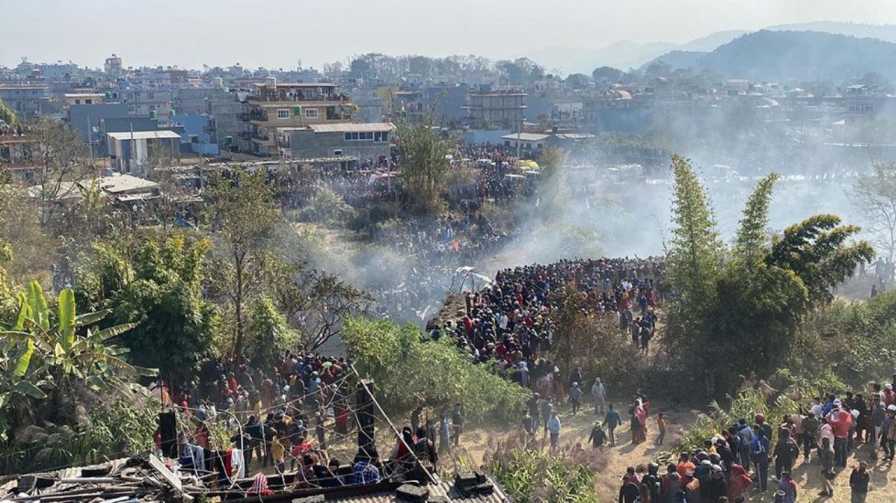Nepal, home to eight of the world’s fourteen tallest mountains, has a history of plane crash. Since 1945, there have been 42 fatal aviation crashes in Nepal, according to the Safety Matters Foundation.

Plane crash in nepal
After a 27-minute flight from Kathmandu, Yeti Airlines Flight 691 crashed just before landing in Nepal’s tourist city of Pokhara, the entrance to a famous trekking destination in the Himalayas. At least 69 of the 72 persons on board were killed.
According to pilots, Nepal may be a difficult location to fly, but circumstances at the time of the incident were favourable, with minimal wind, clear sky, and temperatures well above freezing. So, what may have caused the ATR 72 plane crash?
A stunning video filmed from the ground on a smartphone depicts the final seconds before the plane crashed in a ravine about 1.6 kilometres (a mile) from the recently opened Pokhara International Airport.
According to Amit Singh, an experienced pilot and founder of India’s Safety Matters Foundation, the aircraft’s nose is obviously high before the left wing rapidly descends and the plane falls out of sight of the video, suggesting a possible stall.
“If you look at the trajectory of the aeroplane, the nose goes up, and the nose up is connected with a decrease in speed,” he told The Associated Press. “When they have stalls, normally one wing drops down and wings are basically creating the lift. As the air flow decreases, the lift provided is insufficient to keep the aircraft flying, and the wing descends and the aircraft nosedives.”
Professor Ron Bartsch, an aviation safety expert and the founder of Avlaw Aviation Consulting in Australia, told Sydney’s Channel 9 that the jet seemed to have entered a stall. Its closeness to the ground may have given the pilots the impression that their speed was higher than it was, he added.
“I’d say the aeroplane has reached an aerodynamic stall,” he remarked after seeing the footage right before the disaster. “Perhaps pilot mistake.”
According to Yeti Airlines spokeswoman Pemba Sherpa, the reason of the incident is being investigated.
Issues Concerning on its Aeroplane
The ATR-72 was debuted in the late 1980s as a joint effort between France and Italy, and despite being involved in multiple fatal incidents over the years, many of which were caused by ice, it has a “quite strong track record,” according to Bartsch.
On Monday, searchers retrieved the flight data recorder and cockpit voice recorder from the accident site, but investigators won’t know for sure what occurred until they are thoroughly reviewed.
“Various activities will be an issue that the investigators will look at to determine if sufficient training was provided,” Bartsch added. “However, aeroplanes, especially contemporary aircraft, do not merely fall out of the sky.”
It’s indeed feasible that a technical issue with the aircraft’s equipment provided the pilots with incorrect data, but even in that case, a stall may be recovered from, according to Singh. “The pilots should be taught to deal with technological problems,” he stated.
Despite its “difficult airports and environment,” Singh stated that Nepal’s aviation industry has a dismal track record for safety and training. Despite improvements, he emphasised that its planes are not permitted to fly inside European airspace.
According to a pilot who regularly flies an ATR-72-500 plane from India to Nepal, the region’s landscape, with its high peaks and small valleys, increases the likelihood of accidents and sometimes forces pilots to fly by sight rather than instruments.
The pilot, who works for a private Indian airline and requested anonymity owing to business policy, described the ATR-72-500 as a “unforgiving aircraft” if the pilot isn’t highly trained and familiar with the region’s topography and wind speed.
ATR stated on Twitter on Sunday that its experts were “completely engaged to help both the inquiry and the customer,” and that its “first thoughts are with all those touched by this.” Requests for more comment were not immediately returned by the firm.
Issues Concerning on the new Aeroplane
Nepal, home to eight of the world’s fourteen tallest mountains, has a history of plane crash. Since 1946, there have been 42 fatal aviation crashes in Nepal, according to the Safety Matters Foundation.
According to a 2019 safety assessment from Nepal’s Civil Aviation Authority, the country’s “difficult geography” and “diverse weather patterns” were the key concerns, resulting in a “number of accidents” to light aircraft. According to the survey, such incidents occurred at airports with short runway strips for takeoff and landing, and the majority were caused by pilot mistake.
Pokhara Airport, a major tourist site as the entrance to the Annapurna mountain range, is located at a height of around 820 metres (2,700 feet). Prior to the airport’s inauguration two weeks ago, several voiced worry that the amount of birds in the vicinity — given by two rivers and a dump near the airport — would make it even more dangerous.
According to local media sources, the city’s mayor stated before the airport’s formal opening that work to minimise the effects of the landfill had been finished, but it was unclear what actions were done.
Whereas if plane had been hit by a bird during landing, the pilots could have decided to abandon their approach and circle around again, which might have resulted in a stall, according to Singh. “A high thrust setting might cause a stall,” he explained.